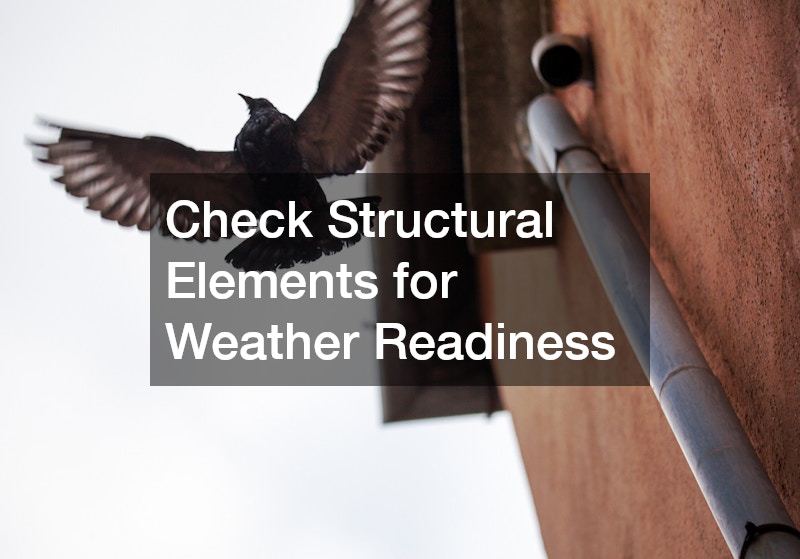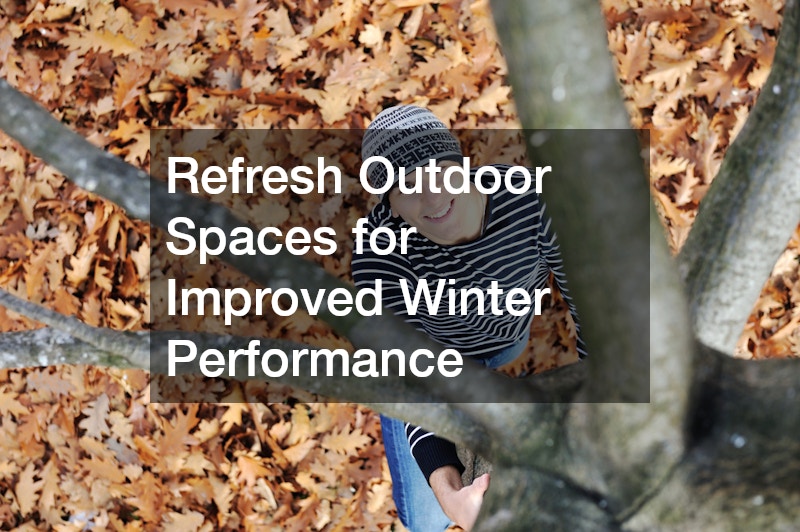
As winter approaches, homeowners often find themselves juggling an increasing list of seasonal responsibilities. Cold weather can be unpredictable, and small issues that go unnoticed during warmer months may quickly turn into costly problems once temperatures drop. Proper preparation can make a significant difference in the performance, efficiency, and longevity of your home’s essential structures. Taking the time to evaluate your property before the first freeze is also one of the most effective ways to maintain comfort and safety throughout the colder season. A thoughtful preventive approach ensures that you stay ahead of potential challenges rather than reacting to them mid-winter.
Preparing for winter does not have to feel overwhelming. Many steps are simple, practical, and manageable for homeowners who want to protect their property without relying on complicated processes or specialized training. By breaking tasks into clear areas of focus, you can examine everything from the exterior surfaces of your home to the condition of trees, soil, fencing, and outdoor features. This blog provides a structured way to examine your home’s key outdoor systems, offering general insight and practical applications you can customize based on what you find. A well-prepped home stands stronger against moisture, storms, and temperature swings—giving you confidence that your property is ready long before winter arrives.
Inspect Your Home’s Exterior Before Temperatures Drop

A general assessment of your home’s exterior is one of the most important steps to complete before the season changes. Over time, exterior materials experience wear from sun exposure, moisture cycles, and environmental factors that weaken their effectiveness. A thorough inspection before winter helps identify issues that may worsen during freezing conditions, such as loose or deteriorating surfaces, weakened joints, or areas prone to moisture intrusion. Homeowners benefit from walking the perimeter of the property with an eye for visual inconsistencies, discoloration, buckling, or irregular shadows that may indicate structural vulnerabilities. This type of simple walkthrough can reveal early warning signs long before they develop into more serious concerns.
This is an excellent time to evaluate the condition of your roofing materials, siding, and exterior fasteners since these components endure the harshest winter conditions. Even a minor issue, such as a small gap or lifted section, can allow cold air or moisture to seep into your attic or wall cavities once freezing temperatures set in. If an issue seems beyond your personal expertise, contacting a roofing contractor can help ensure the problem is accurately diagnosed and resolved. Keeping exterior components in strong condition helps your home stay insulated, energy efficient, and protected from the seasonal changes ahead.
Evaluate Surface Wear to Prevent Seasonal Damage
On a broader level, surface wear should be evaluated with an understanding of how winter impacts different materials. Roofing surfaces, outdoor siding, and trim are all vulnerable to expansion and contraction as temperatures fluctuate. The freeze-thaw cycle can widen existing cracks or create new openings where water can accumulate. Even small areas of wear or fading on exterior surfaces may signal deeper underlying issues. Homeowners who observe and address these signs early can prevent the kind of damage that only becomes evident when snow and ice put additional stress on weakened materials. Routine visual assessments throughout the year make this seasonal check even more effective, especially when completed before the first freeze.
When moving into more detailed inspection tasks, consider the condition of shingles, flashing, gutters, and any areas where roofing sections meet other structural components. Small depressions, missing segments, or deteriorated edges can allow winter weather to significantly worsen the integrity of your home’s protective layers. If you discover irregularities, consulting local roofers for professional insight can provide clarity on whether immediate repair is necessary. Their specialized knowledge helps ensure that issues you may overlook are handled thoroughly before winter conditions amplify them. Addressing surface wear promptly is a meaningful way to reduce the risk of expensive repairs later.
Check Structural Elements for Weather Readiness

Generally speaking, structural readiness for winter involves paying attention to how all major components of your home fit and function together. The foundation, walls, roof, exterior trim, and support structures work as a unified system. If one element becomes compromised, surrounding components may bear additional stress. Winter temperatures amplify these weak points, making it essential to recognize any sagging, shifting, or uneven areas during the fall months. Assessing structural alignment and performance gives you a better sense of how well your home will withstand heavy winds, snow accumulation, and moisture buildup once the cold weather sets in. The goal is to ensure the entire structure remains stable, balanced, and fully sealed.
A more specific step in preparing for winter involves examining roofing joints, attic ventilation, and drainage pathways, since these components directly influence your home’s thermal efficiency and moisture management. Poor ventilation can trap humidity, leading to ice dams or condensation during cold spells. Additionally, improper drainage can cause water to pool in vulnerable spots, increasing the likelihood of winter damage. When uncertainties arise, guidance from a residential roofer can help confirm whether your home’s structural elements are adequately prepared. Their expertise can help detect subtle issues in framing, ventilation, and weather barriers that may not be visible to the untrained eye.
Clear Outdoor Hazards Ahead of Harsh Conditions
In a general sense, clearing hazards around your yard is vital before winter weather creates safety concerns. Overgrown branches, leaning tree trunks, and unstable vegetation can become dangerous when weighed down by snow or ice. Even the gentlest storms can cause weakened limbs to fall unexpectedly, potentially damaging property or blocking pathways. By performing a seasonal inspection of your yard, you can identify which natural elements appear at risk and which areas may require pruning or clearing. A clean, hazard-free yard not only protects your home but also gives you peace of mind throughout the season.
Homeowners should pay attention to trees that have dead branches, signs of decay, or unusual leaning patterns. These indicators often mean that the tree is structurally compromised and more susceptible to breaking under winter stress. If a tree appears unsafe or too large to manage on your own, professional tree removal may be necessary to prevent injury or property damage. Addressing these concerns before heavy snowfall helps ensure outdoor areas remain accessible and free from unexpected hazards once seasonal storms occur.
Refresh Outdoor Spaces for Improved Winter Performance

On a broader level, outdoor spaces benefit from seasonal refreshment, especially as winter approaches. Gardens, lawns, and landscaped areas all undergo natural transitions as temperatures fall, and preparing them properly supports healthier growth in the spring. Clearing debris, removing dead plants, and stabilizing soil can improve overall yard performance while minimizing the risk of erosion or pooling water. Thoughtful winter preparation also helps prevent pests from nesting in neglected outdoor spaces. Even simple steps such as trimming back overgrowth and ensuring adequate drainage improve the long-term vitality of your yard.
Homeowners can enhance winter readiness by tending to flower beds, mulching vulnerable plants, and preparing shrubs and perennial areas for cold weather. When properly maintained, these spaces continue supporting soil structure and plant health throughout the dormant season. If needed, professionals specializing in garden landscaping can help identify plant types that require special attention and recommend strategies for seasonal protection. By addressing these details early, you create outdoor spaces that remain well-kept and resilient despite the challenges of winter.
Strengthen Soil and Ground Cover for Cold-Weather Stability
A general approach to winter soil preparation involves maintaining ground stability and moisture control. Soil shifts naturally throughout the year, but winter brings sudden temperature transitions that can cause rapid expansion and contraction. Areas lacking proper coverage may experience erosion or surface instability once snow melts and refreezes. Strengthening soil and ground cover now helps maintain a more balanced landscape and prevents large portions of earth from shifting unexpectedly. Ensuring soil health also supports plant roots and reduces compaction caused by winter precipitation.
Homeowners may find value in stabilizing bare or thinning areas of their yard with mulch, compost, or protective coverings. These additions help regulate temperature and moisture while preventing soil displacement. In some cases, professional services offered by hydroseeding companies can supply specialized mixtures designed to create even, protective ground cover before winter sets in. Their blends can help reinforce areas that are particularly vulnerable or newly established. Preparing soil properly not only improves winter performance but also enhances spring growth and overall yard health.
Reinforce Perimeter Structures for Added Protection

Broadly speaking, perimeter structures such as fences play a crucial role in protecting your property year-round, and winter can test their durability. Wind, ice, and snow exert pressure that may weaken or displace exposed sections. Examining the perimeter before winter allows homeowners to identify leaning posts, loose panels, or structural inconsistencies that could worsen once cold weather and high winds intensify. A properly reinforced perimeter also prevents unwelcome wildlife from entering the yard in search of shelter during cold months.
Reinforcement involves checking fasteners, tightening hardware, and redriving posts that may have shifted due to soil movement. Wooden fences benefit from sealing or protective coatings, while metal fences may require rust removal or lubrication at key joints. If certain features appear structurally compromised beyond simple repair, a fence contractor can help determine whether reinforcement or partial replacement is necessary. Strengthening your perimeter now will help ensure that the boundary remains stable throughout winter storms.
Review Boundary Features Before Freeze-Thaw Cycles Begin
Generally, boundary features such as gates, access points, and connecting sections need attention before winter begins. These components often experience the most movement due to daily use, and cold weather can magnify existing issues. Freeze-thaw cycles in particular may cause hinges to tighten, screws to loosen, or panels to shift unexpectedly. Conducting a full review of your property’s boundary features helps you identify which areas require minor adjustments before temperatures drop.
Take time to test gate openings, examine support hardware, and verify that structural attachments remain firmly in place. Cleaning and lubricating moving parts can also reduce the strain caused by freezing conditions. When preparing for winter, many homeowners choose to address small repairs early to avoid dealing with stuck or frozen components later. If certain elements require more advanced work, professionals specializing in fence installation can provide guidance and ensure that the boundary features are secure before winter weather affects their functionality.
Assess Outdoor Frameworks for Winter Durability
Generally, outdoor frameworks—such as arbors, trellises, decorative structures, or utility enclosures—should be evaluated for their ability to withstand winter conditions. These frameworks often serve both functional and aesthetic roles, but they may not be built to handle heavy snow loads or strong winds. Seasonal inspections help ensure that these structures remain safe and intact throughout the winter months. Maintenance tasks may include tightening joints, repainting surfaces, or clearing overgrowth that places unnecessary strain on the framework.
Outdoor frameworks should be checked for rot, rust, or warping, as these problems can worsen significantly during fluctuating winter temperatures. Homeowners should ensure these structures have adequate stability and support, especially if they are exposed to the elements. If concerns arise regarding the durability or long-term stability of these systems, contacting a fence company can provide additional insight. Their experience with structural components allows them to recommend appropriate adjustments or reinforcements tailored to your outdoor layout.
Prepare Property Barriers for Seasonal Stressors
At a broad level, preparing property barriers for winter involves making sure all exterior boundaries remain secure against environmental stress. Barriers play an important role in maintaining privacy, defining property lines, and protecting landscaped areas. Winter weather can challenge these systems in multiple ways, from shifting soil to warping materials. A seasonal inspection ensures the full boundary remains aligned, intact, and capable of withstanding significant pressure from snow or ice accumulation.
Property barriers should be checked for loose segments, weakened joints, or materials that show signs of fatigue. Reinforcing these areas may involve replacing fasteners, adding support posts, or re-stabilizing sections that have shifted over time. When issues require more complex solutions, experienced fencing builders can help evaluate the structure and determine an appropriate course of action. Preparing these barriers ahead of winter helps ensure the property remains protected throughout the season.
Winter preparation is a thoughtful process that gives homeowners the chance to evaluate the condition of their property long before harsh conditions set in. By taking a proactive approach, you reduce the likelihood of unexpected damage, safety concerns, or inconvenient repairs during the coldest months of the year. Each component of your home and yard—from exterior surfaces to soil, vegetation, and perimeter structures—plays an important role in overall seasonal performance. Addressing these areas early allows you to maintain a well-balanced, efficient, and secure environment even in challenging weather.
